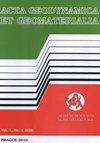Shear modulus and damping ratio of clay soil under repeated freeze-thaw cycles
IF 0.8
4区 地球科学
Q4 GEOCHEMISTRY & GEOPHYSICS
引用次数: 6
Abstract
The dynamic properties of soil deposits subjected to dynamic loading, such as the shear modulus G and material damping ratio D, are important parameters in ground response seismic analysis. In seasonally frozen regions, these properties can be significantly affected by microstructural changes that occur during freeze-thaw cycles. The current study evaluated the dynamic properties of clayey soil exposed to freeze-thaw cycles. Dynamic triaxial testing was conducted to determine the influence of mean effective consolidation stress, cyclic stress ratio, loading frequency, and freeze-thaw cycles on G-γ and D-γ curves. Scanning electron microscopy (SEM) was carried out to investigate microstructural changes in the clay soil fabric. The results indicate the freeze-thaw process has an important effect on dynamic properties of the soil. The dynamic shear modulus increases with increasing effective confining pressure, loading frequency, and confining pressure, and decreases with increasing number of freeze-thaw cycles. Development of more voids between clay particles after ice lens formation during these cycles results in an increase in the damping ratio, but this trend decreases with increasing confining pressure. Increasing the loading frequency increases or decreases the damping ratio depending upon the mean effective confining pressure and number of freeze-thaw cycles. ARTICLE INFO冻融循环作用下粘土的剪切模量和阻尼比
土体在动力荷载作用下的动力特性,如剪切模量G和材料阻尼比D,是地震动分析中的重要参数。在季节性冻结地区,这些特性会受到冻融循环期间发生的微观结构变化的显著影响。本研究评估了冻融循环作用下粘性土的动力特性。通过动三轴试验确定了平均有效固结应力、循环应力比、加载频率和冻融循环次数对G-γ和D-γ曲线的影响。采用扫描电子显微镜(SEM)研究了粘土结构的微观结构变化。结果表明,冻融过程对土壤的动力特性有重要影响。动剪切模量随有效围压、加载频率和围压的增加而增大,随冻融循环次数的增加而减小。在这些循环过程中,冰透镜形成后粘土颗粒之间的空隙增多,导致阻尼比增大,但这种趋势随着围压的增加而减小。增加加载频率会使阻尼比增大或减小,这取决于平均有效围压和冻融循环次数。条信息
本文章由计算机程序翻译,如有差异,请以英文原文为准。
求助全文
约1分钟内获得全文
求助全文
来源期刊

Acta Geodynamica et Geomaterialia
地学-地球化学与地球物理
CiteScore
2.30
自引率
0.00%
发文量
12
期刊介绍:
Acta geodynamica et geomaterialia (AGG) has been published by the Institute of Rock Structures and Mechanics, Czech Academy of Sciences since 2004, formerly known as Acta Montana published from the beginning of sixties till 2003. Approximately 40 articles per year in four issues are published, covering observations related to central Europe and new theoretical developments and interpretations in these disciplines. It is possible to publish occasionally research articles from other regions of the world, only if they present substantial advance in methodological or theoretical development with worldwide impact. The Board of Editors is international in representation.
 求助内容:
求助内容: 应助结果提醒方式:
应助结果提醒方式:


